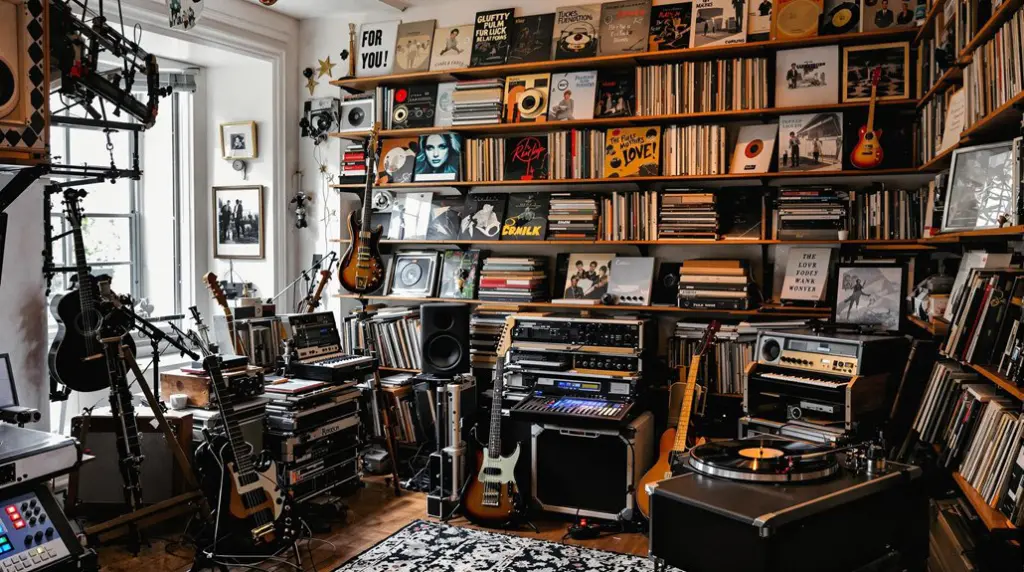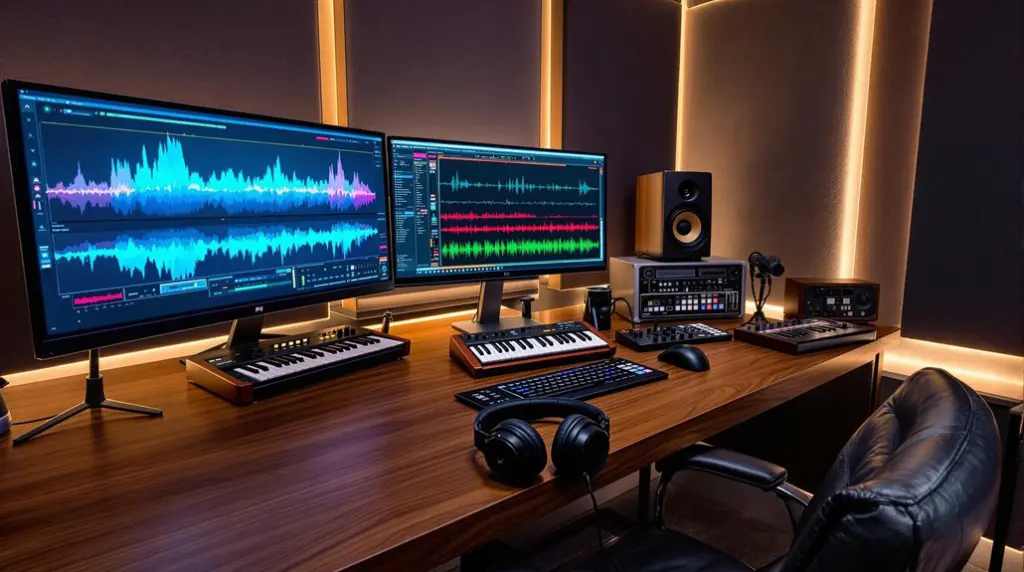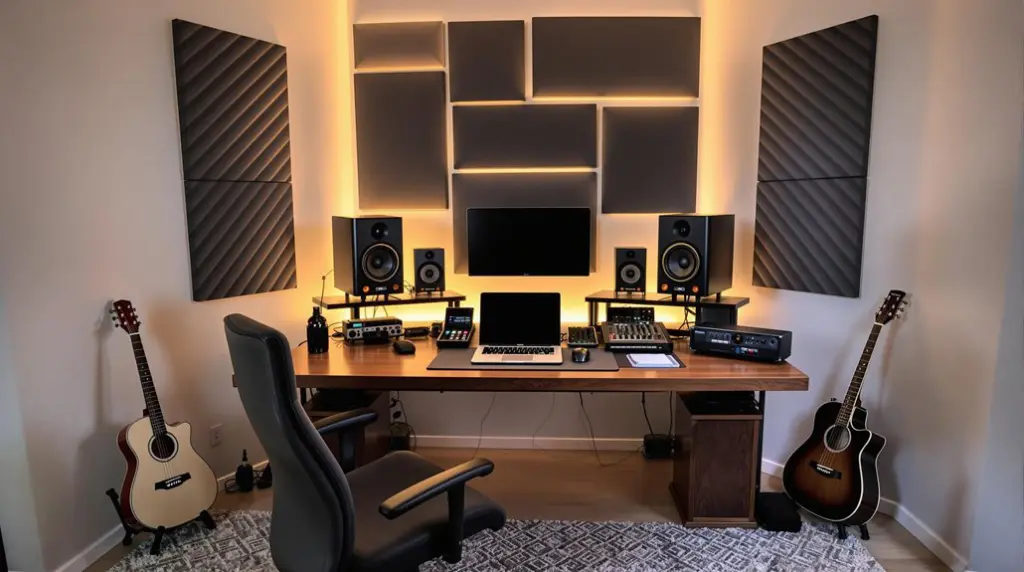To master the art of 808 bass, you need to understand its essential role in genres like hip-hop and electronic music. Start by exploring mixing techniques that use EQ and compression for clarity and punch. Customizing your 808 sounds can also set you apart; record unique samples and experiment with effects. During live performances, guarantee effective level management so your 808 doesn’t overwhelm other elements. Finally, be mindful of legal considerations when sampling. With these expert insights, you can raise your production game to new heights while creating powerful and distinctive 808 bass lines. The journey to sonic mastery awaits!
Key Takeaways
- Learn EQ techniques to carve out frequency spaces for your 808s, ensuring clarity without muddiness in your mixes.
- Explore compression methods to control dynamics and allow your 808 bass to cut through the overall mix effectively.
- Experiment with layering multiple 808 samples to create a rich and powerful low-end presence in your tracks.
- Understand sound design by recording unique sounds and applying effects like distortion to customize your 808 bass.
- Familiarize yourself with legal considerations in sampling to protect your music and respect original creators’ rights.
Importance of 808 Bass
The 808 bass serves as the backbone of many contemporary music genres, particularly in rap, hip-hop, pop, and electronic/trap. Its low end provides the deep beats that drive tracks, ensuring an emotional and physical impact. Originating from the iconic Roland TR-808, this sound has evolved into a versatile tool in hip-hop production and sound design. Mastering the 808 bass is essential for music producers, as it helps create a solid kick drum sound that complements the overall mix. However, you must pay attention to avoid muddiness, which can obscure your music’s clarity. By understanding the importance of 808 bass, you can enhance your productions and craft tracks that resonate with listeners on multiple levels. Additionally, employing techniques like using a High Pass Filter can help maintain clarity by rolling off unnecessary low-end frequencies.
Techniques for Mixing 808s
Mixing 808s effectively can transform your track, giving it depth and power. Here are some key techniques to enhance your production:
- Use EQ to carve out frequency spaces, ensuring clarity and preventing muddiness.
- Apply compression to control dynamics, allowing your 808 to cut through the mix.
- Experiment with layering multiple 808 samples for a richer low-end.
- Additionally, consider boosting upper mids to enhance clarity and presence in your 808 sound.
Customizing 808 Sound Design
Transforming your 808s goes beyond mixing; it’s about crafting a sound that reflects your unique style. Start by recording unique sounds, like door slams or vocal hums, to create custom 808s that add distinctive textures. Import compelling 808 samples into your DAW and isolate segments for manipulation. Use effects like distortion and compression to shape your sound design. For fluid changes, apply pitch envelopes and portamento settings to a clear-toned 808 sample. Layer multiple 808 samples, ensuring each serves a distinct purpose, to enrich your low-end presence. Additionally, focusing on managing low-end frequencies is crucial to prevent muddiness and ensure clarity in your mix.
| Technique | Purpose | Tools |
|---|---|---|
| Custom Sounds | Unique Texture | Field Recordings |
| Sample Manipulation | Stand Out | DAW Isolation |
| Effects | Tailored Sound | Distortion, Compression |
| Pitch Envelopes | Smooth Changes | MIDI Modulation |
| Layering | Richer Low-End Presence | Multiple Samples |
Live Performance Integration
Incorporating 808 bass into live performances presents a unique set of challenges and opportunities, especially when blending electronic sounds with acoustic instruments.
You’ll want to focus on:
- Effective level management by sound engineers to maintain clarity.
- Advanced mixing techniques like EQ and compression for ideal resonance.
- Real-time manipulation of effects to enhance audience engagement. Additionally, applying compression techniques can help balance volume levels across your mix, ensuring that the 808 bass complements other elements without overwhelming them.
Legal Considerations in Sampling
When you’re blending live performances with 808 bass, it’s easy to overlook the legal implications of sampling those signature sounds. Understanding copyright laws is essential to avoid potential lawsuits. Proper licensing agreements guarantee you respect the intellectual property rights of original creators. While Fair Use might offer some flexibility, it’s often misinterpreted, making reliance on it risky. Not all samples need clearance, but knowing the original source is critical for maintaining artistic integrity. Engaging with the community can provide valuable insights into these issues and promote ethical music production. Additionally, familiarize yourself with public performance licenses to ensure compliance during your performances.
| Aspect | Details |
|---|---|
| Copyright Laws | Protects original creators’ rights |
| Licensing Agreements | Required for legal use of samples |
| Fair Use | Risky; often misinterpreted |
| Community Engagement | Key for insights and best practices |
Frequently Asked Questions
What Software Is Best for Creating 808 Bass Sounds?
For creating 808 bass sounds, consider DAW comparison for compatibility, synth selection for versatility, and sample packs for authenticity. Explore plugin recommendations, sound design techniques, and processing effects to enhance your production across genre-specific tools.
How Do I Layer 808S With Other Instruments Effectively?
To layer 808s effectively, utilize layering techniques for harmonic layering and rhythmic patterns. Focus on frequency balancing and volume levels, ensuring melodic integration and genre fusion, while applying effects processing for a polished sound design.
Can I Use 808S in Genres Outside of Hip-Hop?
Absolutely, you can use 808s beyond hip-hop! Their versatility shines in pop, electronic, indie, and even jazz fusion. Experiment with 808 ambient sounds or integrate them into rock and dance tracks for unique textures.
What Are Common Mistakes Beginners Make With 808 Bass?
Beginners often make tuning mistakes, neglect mixing volume, and misjudge note length. Watch for frequency clashes, poor sample selection, distortion issues, and improper rhythm placement. Effective sound design and effects usage can enhance your 808 experience considerably.
How Do I Choose the Right 808 Sample for My Track?
To choose the right 808 sample, consider genre-specific 808s, tuning your 808 for key compatibility, and explore punchiness vs sustain. Layering techniques explained can enhance depth, while sound design fundamentals guide effective sample selection.
Conclusion
Mastering 808 bass is essential for any producer looking to create impactful tracks. By honing your mixing techniques, customizing your sound design, and integrating these elements into live performances, you’ll enhance your music to new heights. Don’t overlook the legal aspects of sampling, as they can safeguard your creativity. Embrace the art of 808 bass, and you’ll release a powerful tool that resonates with your audience, making your sound truly unforgettable. Keep pushing the boundaries!




